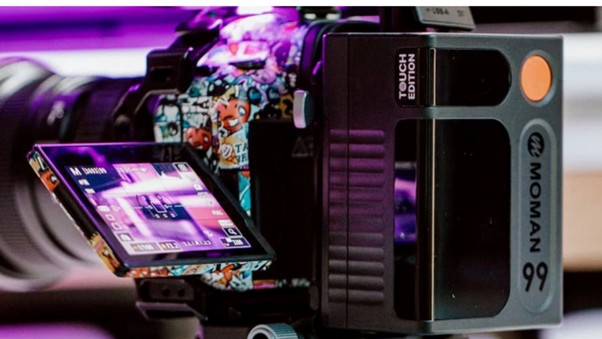Source: Moman
In modern filmmaking and professional video production, reliable power isn’t just a convenience — it’s a necessity. When you’re running a cinema camera, external monitor, wireless transmitter, follow focus system, and LED lights, juggling multiple batteries becomes inefficient. That’s why filmmakers are turning to the V-mount camera battery — the industry-standard solution that delivers high capacity, flexibility, and long-lasting power.
Let’s break down everything you need to know about v-mount batteries, how to connect them, what cameras they support, and why they’re the go-to choice for powering entire filmmaking kits.
What Is a V-Mount Camera Battery?
A V-mount camera battery, also known as a v-lock battery, is a professional-grade power solution widely used in the film and broadcast industry. Named for its V-shaped locking mechanism, this battery securely attaches to a mounting plate and delivers power to cameras and other gear.
These batteries are known for their high capacity, multiple output options, and rugged durability — all features that make them ideal for powering complete setups on set, in the studio, or in the field.
Why Use a V-Mount Battery for Filmmaking?
The V Mount battery is an essential power solution in filmmaking, providing reliable, long-lasting power for cameras and other gear on set.
1. High Power Capacity
Unlike standard camera batteries that may only last an hour or two, large v mount camera batteries can power your gear for 6–12 hours or more, depending on the load. This is especially useful for long shooting days where changing batteries frequently isn’t practical.
2. Multiple Output Ports
Most v-mount batteries include several power outputs:
- D-Tap ports (12V) for powering cameras and accessories
- USB ports for mobile devices or on-camera lights
- Regulated DC outputs (7.4V, 12V, or even 15V) for gear that requires specific voltages
This makes it easy to power everything from your cinema camera to your wireless follow focus, field monitor, or even a portable LED panel — all from a single battery.
3. Streamlined Setup
Using a single v-mount battery reduces the number of cables, chargers, and battery swaps on set. This keeps your rig clean, your workflow efficient, and your production running smoothly.
What Cameras Use V-Mount Batteries?
V-mount batteries are incredibly versatile and compatible with a wide range of professional and semi-professional camera systems. Some of the most common setups include:
Cinema Cameras
Cinema cameras from major manufacturers are typically designed to run off external power. These include high-end models used for feature films, commercials, and documentaries. For these systems, a V-mount camera battery is often the default power source.
Blackmagic Cinema Cameras
If you’re working with a v mount battery for Blackmagic Cinema Camera, you’re in good company. Many filmmakers use v-mount batteries with the Blackmagic URSA, Pocket Cinema Camera 6K, and v lock battery for BMPCC 4K to achieve longer shoot times without the need for internal batteries.
A V lock battery for BMPCC 4k can easily power your camera for 6 to 10 hours, while also powering your monitor and other gear. This transforms the BMPCC 4K from a short-runtime camera into a full production-ready rig.
Mirrorless and DSLR Cameras (With Adapter Plates)
Even if your camera doesn’t have a native v-mount connection, you can still use a v-mount battery by attaching a v-mount plate to your camera rig. This setup is popular with hybrid shooters who use cameras like the Sony A7 series, Canon R-series, or Panasonic GH6.
How to Connect a V-Mount Battery to a Camera
The beauty of the v-mount system lies in its modularity. You can use it with almost any camera — as long as you have the right plate and cable.
Step 1: Attach a V-Mount Battery Plate
A v-mount battery plate acts as the interface between your camera and the battery. These plates often mount to a cage or rig and include various output ports.
Step 2: Choose the Right Output
- For cameras, you’ll typically use the D-Tap or a regulated 12V/14.8V output.
- For accessories like monitors or wireless transmitters, you might use a 5V USB or 7.4V output.
Step 3: Use the Correct Power Cable
Depending on your camera model, you’ll need a specific cable. For example:
- BMPCC 4K and 6K: Use a D-Tap to 2-pin power cable
- DSLR/Mirrorless: Use a dummy battery adapter connected to a D-Tap output
- Professional Cinema Cameras: Often have a direct 4-pin XLR or 12V input
Make sure the cable is rated for your camera’s voltage and amperage requirements.
Tips for Using V-Mount Batteries on Set
- Monitor Your Power Levels: Many v-mount batteries have built-in displays or LED indicators to show how much charge remains.
- Carry Spares: Even though they last long, having at least one extra battery ensures you’re covered for long shoots.
- Label Your Gear: When you have multiple batteries and accessories, proper labeling helps keep your setup organized.
- Invest in a Dual or Quad Charger: This lets you charge multiple batteries simultaneously and stay ready between shoots.
Final Thoughts
If you’re serious about filmmaking, investing in a V-mount camera battery setup can be one of the smartest decisions you make. Whether you’re running a full cinema rig or simply need a more reliable power source for your Blackmagic Cinema Camera, v-mount batteries provide extended runtime, flexibility, and professional-grade reliability.
By learning how to connect v mount battery to camera, and knowing what cameras use v-mount batteries, you’re already on your way to a more efficient and powerful production workflow.



